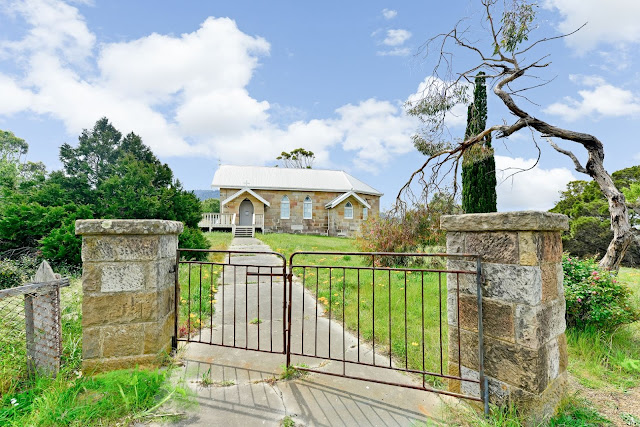Wilmot is a village on the Wilmot Road approximately 30 kilometres south of Ulverstone. The district was named after Sir John Eardley-Wilmot, who was the first non-military Governor of Tasmania. The area wasn't settled until the 1890s and was called “The Junction” by the locals. Settlers were challenged with the difficult task of clearing land which was densely timbered and where roads were poor in an isolated district difficult to access. In 1899 a visiting reporter for the Examiner wrote:
“I might state that I asked a leading resident of the Upper Wilmot what name it was proposed to bestow on the new settlement, and he replied: "Well, if the Premier treats us handsomely in the matter of roads, we will call the place "Braddon Town or Braddonville."
In 1903 the settlement was officially proclaimed as Wilmot and by this time it had two churches; a Wesleyan Methodist church built in 1899 and an Anglican church, St John the Evangelist, which opened two years earlier. Little is known of the early years of the Anglican church and I have found only a single newspaper reference to the church’s establishment in 1897:
“A correspondent writes from Upper Wilmot : — The district has been making rapid strides owing to tho energy of its settlers, and an instance of its progress may be taken the fact that a piece of land has been given by Mr Diprose on which a building for an English Church is to be erected, and which will also be used as a State school. I hear that there will be between twenty and thirty scholars. On Tuesday a working bee was held, when a number of energetic residents took an active part in helping to fell the timber and clear the land, and the ladies…provided the refreshments well deserved by the workers.…”
I have found no reference to the church’s opening but it did feature in a report published in mid 1899 when it was used as a public hall for a visiting group of parliamentarians who were investigating the establishment of a Kentishbury Railway. The parliamentary group was met by a reception committee opposite the Church of England:
“The township of Wilmot, though situated right in the midst of the woods, was quite en fete for the occasion, and it appeared as if the whole of the population for miles around, ladies included, had turned out to pay homage to the distinguished visitors. A line, or probably what in cities would be designated a triumphal arch, extended across the road opposite Mr T. J. Clerke's store. From this depended a banner on which was emblazoned the word “Welcome”, truly an appropriate index to the hospitality of the good folk of the Wilmot, while on either side the British ensign was conspicuously displayed. The building recently erected for tho Church of England was called into requisition as a public hall for the occasion. The entrance was decorated with bunting in miniature, and a nice little show of some of the products of the district in farm and garden, and specimens of copper and silver ores from the Falls Creek, was set up outside the building….Three hearty cheers were given for the visitors. Mr L. Vaughan in a few appropriate words, extended a cordial welcome on behalf of the Wilmot settlers, who had arranged to entertain the visitors in the church. The interior was decorated with fern fronds, and two improvised dining tables extended, throughout the entity length of the building”.
Wilmot never got a railway line but the district did prosper and the population swelled to about 1100 people at its peak. It has now shrunk to around 300 and the Anglican church closed about twenty years ago. The building now houses the Wilmot Museum and Information Centre which has a remarkable collection of historical artifacts and memorabilia relating to the history of the district including settlements at Erriba, Daisy Dell, Moina and Cethana.
 |
| Photograph: Duncan Grant 2019 |
 |
| Photograph: Duncan Grant 2019 |
 |
| Photograph: Duncan Grant 2019 |
 |
| Photograph: Duncan Grant 2019 |
 |
| Photograph: Duncan Grant 2019 |
 |
| Photograph: Duncan Grant 2019 |
 |
| The original church organ. Photo: Duncan Grant |
 |
| Wilmot's Honour Roll now housed in the Wilmot Museum - Photo: Duncan Grant |
 |
| The original font - Photo: Duncan Grant |
 |
| The Royal Antedeluvian Order of Buffaloes - the Wilmot Order - Photo: Guncan Grant |
 |
| A view of the sanctuary - with original altar rails visible on the left |
 |
| The location of Wilmot - source: placenames.tas.gov.au |
Sources:
The North West Post, Saturday 10 April 1897, page 2
Federalist, Saturday 5 November 1898, page 11
The North Western Advocate and the Emu Bay Times, Monday 3 July 1899, page 2
Launceston Examiner, Friday 5 May 1899, page 2
Advocate, Thursday 20 May 1948, page 4
Henslowe, Dorothea I and Hurburgh, Isa Our heritage of Anglican churches in Tasmania. Mercury-Walch, Moonah, Tas, 1978.
http://think-tasmania.com/wilmot/
https://www.facebook.com/wilmotmuseum/















Comments
Post a Comment